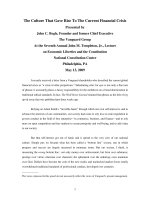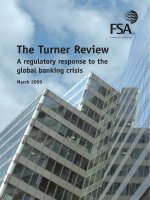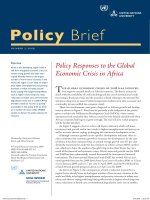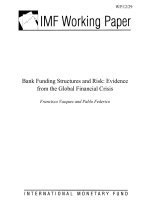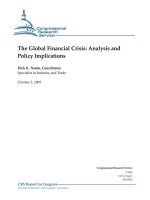Some solutions of Vietnamese government to the impact of the global financial crisis
Bạn đang xem bản rút gọn của tài liệu. Xem và tải ngay bản đầy đủ của tài liệu tại đây (125.2 KB, 10 trang )
<span class='text_page_counter'>(1)</span><div class='page_container' data-page=1>
103
Some solutions of Vietnamese government to the impact of
the global financial crisis
Assoc.Prof.Dr. Mai Thi Thanh Xuan*
<i>Faculty of Political Economy, University of Economics and Business, </i>
<i>Vietnam National University, Hanoi, 144 Xuan Thuy, Cau Giay District, Hanoi, Viet Nam </i>
Received 11 September 2010
<b>Abstract.</b>The global financial crisis started in the United States and blew all over the world in
2007 - 2009 was one of the worst crisis that impacted almost countries around the world. Vietnam
although was not directly and quickly influenced by the crisis, most of its economic activities were
passive and the economy growth even fell down. The Vietnamese government was very active to
implement policies to react to the global financial crisis. They however were just temporary
because they were only short term reactions or saved the economy of Vietnam from the crisis but
they created neither sustainable, long term factors nor growth motivation for the economy itself
and enterprises as well.
<b>1. Overview of the global financial crisis and </b>
<b>its impact on the Vietnamese economy</b> *
<i>Overview of the global financial crisis </i>
<i>2007-2009 </i>
The crisis that broke out in the middle 2007
in U.S. recently was the most severe one since
the Great Depression 1929-1933. It originated
from the panic of the mortgage market, then
spread to the stock market and the banking
system. It "submerged" many economies,
“cleared” large companies including world
leading banks and financial institutions such as
Bear Stearns, Lehman Brothers, Merrill Lynch,
Fannie Mae and Freddie Mac, AIG (US),
London Scottish Bank (UK), Fortis (Belgium),
Hypo Real Estate Holding AG (Germany), FCG
(Japan), etc.
______
* Tel.: 84-4-38586385
E-mail:
</div>
<span class='text_page_counter'>(2)</span><div class='page_container' data-page=2>
The crisis pulled down these economies and
led to declined employment, income but boost
social issues on a rise. In 2008, the world
economic growth rate decreased 1.1% compared
to 2007 and 1.2% in 2006 (only 3.9%), of which
developed countries decreased respectively 1.1%
and 1.5% (1.5%); ASIAN NICs decreased 3.6%
and 4.2% (1.5%). In the developing countries
however as poorly open economies, the impact of
the crisis was not as strong as it was for the
developed countries. The growth rate, therefore,
was 6.9%(1) (see Figure 1).
Figure 1. Quarterly economic growth rate (Worldwide, 2005-2009).
Figure 1. Quarterly economic growth rate (Worldwide, 2005-2009).
<i><b>Source: </b></i>
(1)
Although the financial crisis became
intense in 2008, its consequence broke out in
2009. The world economy growth rate only
reached 1.1%, decreased 2.8% compared to that
of in 2008. The international trade declined
more slowly than in 2008 but was still high
(declined 11.9% in 2009, 20% in 2008). The
declined trade strongly affected the exporting
economies, including Vietnam's main markets
such as Hong Kong, Singapore, South Korea,
Thailand and Malaysia. In order to rescue, most
countries pumped money into their economies
through stimulus packages with hundred or
even thousand billion dollars. According to the
Asian Development Bank (ADB), this crisis
dashed around 50,000 billion dollars (excluding
the damage caused by the economic recession).
Interventions had helped some economies to
recover, but fell into another disaster - a debt
disaster, in which the U.S. became the world
______
(1)
Economic of 2008-2009, Vietnam and the World
(Vietnamese), Journal of Vietnamese Economy, p. 131
largest debtor with government debts of 9,130
billion USD, accounting for 65% of GDP(2).
Many countries, although their debt was not as
much as the U.S.’s, were alarmed of the risk of
default, including the world leading economies.
<i>BusinessWeek launched a list of 10 countries at </i>
risk of "drowning in debt" since the debt/GDP
ratio was at dangerous level, typically Iceland,
with debt in 2009 was 310% of GDP, followed
by Japan 227%, Greek 124% and Italian
120.1%(3).
<i>Crisis impacts on the Vietnamese economy </i>
In Vietnam, the impact of the crisis seemed
to be slower and lighter than many other
countries. Until late 2008, after nearly a year of
______
(2)
Global crisis and some problems for the Vietnamese
economy (Vietnamese),
/>id=13758
(3)
</div>
<span class='text_page_counter'>(3)</span><div class='page_container' data-page=3>
the crisis in the U.S., Vietnam really witnessed
the economic decline. The impact was lighter
because firstly, while other countries had to
close series of enterprises, many new
enterprises were established in Vietnam (21,000
new established enterprises in first 6 months of
2009); secondly, while many leading
enterprises of powerful economies went
bankruptcy, in Vietnam the large enterprises are
still stayed, only about 20% of enterprises
(mostly small and medium size) were at risk of
bankruptcy; and thirdly, while most countries
severely degraded, many countries got negative
growth rate, Vietnam achieved positive growth
rate with 3.14% even at the worse time of the
crisis - first quarter of 2009 - and as twice as
the world growth rate in 2008(4).
Despite the fact above, it did not mean that
impact of the global financial crisis to the
Vietnamese economy was small. Conversely,
the impact was a bit strong compare to the
stamina of the country.
Export sector was firstly, most directly and
heavily affected by the crisis. This is because
on one hand, Vietnam economy is an open
market (export – import accounts more than
150% of GDP); on the other hand, the U.S. - the
epicenter of the crisis - is the biggest export
market of Vietnam (usually accounts for
23-25% of total export turnover), and other major
markets such as Japan, EU, Australia were also
seriously degraded. Therefore, import demand
in these countries was significantly reduced
(consumers applied “tightening the belt”
policy). In addition, right from fourth quarter of
2008, most of these markets increased
protection and refused orders to deal with lack
of liquidity and to protect domestic enterprises.
It significantly reduced price and volume of
imports. As consequence, in the second half of
2008, export turnover of Vietnam began to
decline. The proportion of U.S. and EU markets
______
(4)
Financial crisis depresses the World economy
(Vietnamese),
/>9&tmpl=component&print=1&page=&option=com_content
in the total export turnover of Vietnam reduced
from 20.7% and 18% in 2007 to 17.7% and
16.5% in first 9 months of 2008(5). In 2009,
turnover from seven major export markets of
Vietnam (accounting for nearly 80% of the total
export turnover of the country) are lower than
in 2008, in which the U.S. market decreased by
5.5%, EU 14.4%; ASEAN 16.4%, Japan
27.7%,etc. Compared to 2008, total export
turnover of Vietnam reduced 10% (about 6.3
billion dollars), of which crude oil decreased
40.2%, shoes 14.7%, etc. To be worse, many
products increased in volume but significantly
reduced in turnover (due to falling prices), such as
rubber increased 11.1% in volume but decreased
23.5% in turnover; the corresponding figures were
11.7% and 18% for coffee, 25.7% and 8% for
rice, 7.1% and 7.2% for cashew nut(6).
Clearly, the export enterprises of Vietnam
were influenced by the global financial crisis.
They not only faced a decrease in demands, but
also must deal with many additional effects,
such as increasing the price of US dollar,
tightening credit activities, etc.
In the activities of FDI, thank to the
“inertia" of the investment flow from 2007,
Vietnam still achieved a remarkable record of
registered capital in 2008 with 64.1 billion U.S.
dollars, which was 3 times higher than 2007
and 5.3 times higher than 2006. However, the
impact of the global financial crisis led to a
slowdown of implementation progress of
investment projects since investors had to
tighten their budgets. The implementation
capital rate in 2008 only reached to less than
18% (the rate of 2007 was 37.6% and 2006 was
34.5%). In 2009, as the largest investment
partners of Vietnam such as Taiwan, Malaysia,
______
(5)
Impact of global financial crisis on foreign investment
and economic growth of Vietnam in several upcoming
years (Vietnamese),
/>id=12741
(6)<sub>Export and Import situation of December and the whole </sub>
year 2009 (Vietnamese),
</div>
<span class='text_page_counter'>(4)</span><div class='page_container' data-page=4>
Singapore, Japan, and Hong Kong were in
heavily economic recession, FDI in Vietnam
was also sharply reduced. The amount of
registered capital in 2009 was only 21.4 billion
(including supplementary capital), decreased
70% compared to 2008. Especially, this amount
was only 300-400 million in many months.
Implementation capital in 2009 was estimated
to reach $10 billion, decreased $1.5 billion
(13%) compared to 2008.
Crisis also affected the flow of indirect
investment into Vietnam over these 3 years. If
in 2007 indirect investment accounted for 8.6%
of GDP, in 2009, this rate was only 2%. The
crisis pushed investors into difficulties in
searching financial resources, so they did not
want to invest more, or even had to withdraw
capital to invest in less risky sectors. In
2008-2009, the amount of indirect investment
withdrawn from Vietnam each year was about
600 million(7), which showed that foreign
investment in Vietnam was not beyond the
influence of the crisis.
Although monetary and financial sector in
Vietnam was not as intense as the U.S. and
other European countries because it was not
directly affected by the crisis, however, in the
first half of 2008, the operation of this market
had many changes: interest rates rose, bond
market began to stagnation and stock market
continuously declined. In the monetary market,
within 4 months (from February to June 2008),
the basic interest rate increased 2 times which
was from 7.25% per year to over 14% per year.
Interest rate of capital mobilization increased up
to 17-17.5% per year, the Bank of East Asia
even raised it up to 19.2% for the 3-month
period. In the interbank market, interest rate
was even higher, up to 40% per year (March
and April of 2008). Accordingly, the interest
rate of loan also increased, even up to 21% per
year. At that time, the credit of commercial
______
(7)<sub>Portfolio foreign investment of 2009 decreased along </sub>
with recession (Vietnamese),
/>px?co_id=30066&cn_id=391163#
banks was in the "hot" state, especially real
estate outstanding loans in two economic
centers - Hanoi and Ho Chi Minh City.
Generally, within the first 3 months of 2008
(January to March), outstanding loans of
commercial banks in the whole country
increased by 180,000 billion Vietnamese
dong(8).
In the stock market, the decline also
appeared. Compared to early 2008, the
VN-Index declined almost 70%, of which the
HASTC-Index fell below 100 points at some
points of time. This situation led to a number of
foreign investments (about $500 million) to
withdraw from the stock market in Vietnam.
Those numbers were not large compared to the
total value of market capitalization, but it had a
strong influence on investors, making the
market becomes bleak. There was data
displaying within a month that both HASTC
and HOSTC sharply lost points, respectively
17.9% and 24.9%. This dragged the loss of
VN-Index from 859 points on February 20, 2008 to
428.05 points on May 30, 2008(9).
An increase in interest rate led to an
increase in capital price. Vietnamese
enterprises, therefore, could not escape from the
crisis. In late 2008, there were more than
200,000 over 300,000 enterprises strongly
affected by the crisis, including 70,000
businesses and a half of handicraft villages
(about 5 million out of 10 million households)
were before the brink of bankruptcy. The
growth rate of the economy was slower since
late 2008. From the peak of growth of 8.48% in
2007, right in the first quarter of 2008, this
number dropped to 7.4%. After that, the
economy continued to slowdown and led to a
growth rate of only 6.23% in 2008. Decline also
extended to the first three months of 2009.
Economic growth rate in the first quarter of
______
(8)
Economic of 2008-2009, Vietnam and the World
(Vietnamese), Journal of Vietnamese Economy, p. 14
(9)
</div>
<span class='text_page_counter'>(5)</span><div class='page_container' data-page=5>
2009 reached only 3.14% - its lowest level over
the two decades. The crisis dragged the growth
rate of 2009 down to 5.32%, less than 0.91
percentage points compared to 2008, and 3.13
percentage points compared to 2007.
Unemployment went along with the crisis.
Series of business had to narrow their
operations or even closed down. It made fairly
large number of workers temporarily off work
or lost their jobs. In 2007, the number of
workers in companies operating in industrial
zones and export processing zones were cut
down to 541,000 people. By 2008 that number
was 30,000(10). In the first 9 months of 2009,
110,818 employees in the business sector lost
their jobs, of which women accounted for 31%.
In the handicraft village sector, the number of
unemployment also reached to 40,348 people,
of which women was 41.2% (excluded more
than 100,000 people had to stay rotation due to
lack of work)(11). Even Vietnamese employees
working overseas were in a fear of losing jobs,
since the large markets such as Taiwan, Korea,
Singapore, Malaysia and Czech Republic not
only stopped reception, but also managed to
bring workers back to Vietnam before the due
time. The weak groups such as women workers,
rural workers, workers in industrial zones were
the one who might lose the most.
<b>2. Vietnamese government’s solutions under </b>
<b>the impact of global financial crisis </b>
<i>Public spending sharp cut and managing </i>
<i>improvement </i>
Since March 2008, the Government of
Vietnam had anticipated the problem of the
U.S’ economy and planned to prevent in time.
______
(10)
Vietnam starts to feel results of the global financial
crisis (Vietnamese), 14/2/09,
/>
(11)
Number of job-lost workers decreased in the third
quarter of 2009 (Vietnamese),
o/?pc=news&p=estore&id=2118&cid=9
Resolution No. 10/2008/NQ-CP on April 17,
2008 proposed the specific measures to prevent
crisis, including measures to reduce public
spending, notably from the budget. Public
spending is necessary for countries, but in
Vietnam, it was not used efficiently while the
budget was deficit due to crisis. Therefore, in
2008, the government decided to cut 10% of the
average administrative costs of agencies using
the State budget. Firstly, it was expense on
unnecessary activities such as festivals,
ceremonies, meetings, travels, etc. This was
considered a wise and in time decision of the
Government, in order to save capital for
production. Secondly, it was expense on
inefficient investments or unnecessary works,
and in replacement, focused on nearly
completed works and efficient works. After the
policy was implemented, the growth rate of
government spending in 2008 was nearly 1%
lower than in 2007 (8% compared to 8.9%).
Although the speed was still slow, this number
still was a worth in the situation of facing crisis.
Along with cuts in expenditures from the
state budget, the Government also reviewed
investment activities from loans, and limited
total investment loans for SOEs, firstly
economic groups and Corporation 90 and 91.
<i>Tax extension and exemption for business </i>
<i>activities </i>
</div>
<span class='text_page_counter'>(6)</span><div class='page_container' data-page=6>
soil stones, sand, gravel, mechanical products
as production tools, automobile and automobile
components (including engines, gearboxes,
clutches), industrial concrete products, color
metals, precious metals (except import gold),
etc. Also for the labors, the Government
advocated to extend personal income tax in the
first 5 months of 2009.
<i>Carrying out demand stimulus </i>
To cope with economic recession, demand
stimulus (both for investment and consumer
demand) is the solution that many countries
have been applied. Vietnam Government
created two demand stimulus packages in 2009
which was an unprecedented case in Vietnam.
The first package which worth $1 billion
was carried out from Feb. 1, 2009 to Dec. 31,
2009; and the second package which worth $8
billion was implemented from April 1, 2009 to
Dec. 31, 2011. The purpose of these two
packages was to support organizations and
individuals through interest rates when
borrowing from the banking system. Interest
rate support level was 4% (less than half of
bank’s interest rate). Supporting objectives
were organizations and individuals, especially
small and medium enterprises who engaged in
business sector. The first package was to
"rescue", the second package was to “pushing
up” the economy.
Just two months after the implementation of
the first package, there was more than 202,130
billion Vietnamese dong of supporting loans
reached the borrowers. For the whole year,
there was 415,216 billion dong being lent by
banks and credit institutions with supporting
interest rate, in which state-owned enterprises
borrowed nearly 60,000 billion dong, non-state
enterprises 290,000 billion and the households
over 65,000 billion. Thanks to the supporting
package, many enterprises had overcome the
difficult period caused by the global financial
storm. In rural areas, the Government also spent
51 billion dong to assist farmers purchasing
more agricultural tools and materials, whereby
rural people were not only out of crisis, some of
them even get out of poverty in a sustainable
manner. Thus, with these two economic
stimulus packages, Vietnam has pumped and
will pump into the economy more than 146,000
billion dong (approximately $8.6 billion), in
which regular expenditure for the welfare was
about 9,800 billion(12). Up to now, the first
package was completed and has promoted
effectiveness in rescuing the economy out of
recession. The second one has been
implemented.
In addition to compensation for interest
rates, the Government also approved the credit
guarantee mechanism for enterprises with initial
capital of less than 20 billion and less than 500
employees (excluding the service sector).
Guarantee’s duration matched with loan
duration and business cycle with the maximum
guarantee level of 100% for original loan and
interest incurred. Maximum guarantee fee
equaled to 0.5% of the amount guaranteed per
year. Initial capital for the Risk compensation
fund, which was 200 billion dong, was
allocated to the Vietnam Development Bank.
<i>Implementation of flexible monetary - </i>
<i>financial policy </i>
Vietnam's economy has not yet escaped
from the heavy impact of inflation in 2007
(with highest CPI of 12.63% since 1996), still
then it had to confront the financial crisis.
Operating monetary policy in the condition of
fighting both inflation and economic recession
was not easy. Like many other countries, the
Government of Vietnam used the monetary
policy to attack the two targets above.
In the last few months of 2007 and early of
2008, when prices of goods and services were
highly increased, the Government directed the
State Bank to expand the scope of carrying out
the requirement reserve ratio for deposits over
______
(12)
</div>
<span class='text_page_counter'>(7)</span><div class='page_container' data-page=7>
24 months (previously was not higher than 24
months), and to increase 1% requirement
reserve ratio (10% from May 2007).
The next step was to change the ratio of
outstanding loans for securities to not exceed
20% of initial capital of credit institutions
(previously was 3% only). In 2008, facing the
fluctuation of the domestic and global
economic situations, the Government of
Vietnam adjusted 8 times for basic interest rate
(especially five times for the last 3 months of
the year) and re-discount interest rate; 5 times
for reserve requirement and reserve requirement
interest rate; 3 times for exchange rate; and 2
times strongly increased the inter-bank rate.
Change in monetary policy was "tightening" at
the beginning and gradually "loosening" at the
end of the year(13).
Along with an increase in interest rates, the
Government released 20,300 billion dong of
obligated bonds to commercial banks, strictly
controlled the securities and property
investment loans; and strengthened the
management of foreign currency exchange
dealers. Those policies and measures proved its
effect in inflation control: consumer price index
decreased from 3.91% in May to 2.14% in June,
and 0.18% in September, 2008.
In 2009, monetary policy was more stable,
thank to the policy impact of 2008. During the
year, the State Bank reduced basic interest rate
only once from 8.5% to 7% per year in
February, and maintained to the end of
November. It increased again to 8% in
December 1st. There were three adjustments in
re-discount and re-financing rates, two in Jan
and April, and one in December. There was one
time reduction in requirement reserve ratio in
March. There was also 2 adjustments in
exchange rate amplitude: one time widening
from ± 3% to ± 5% on March 24th, and one time
narrowing from ± 5% to ± 3% on Nov 26th.
______
(13)
Monetary policy in globalization (Vietnamese),
o/index.php?option=com_content
&task=view&id=2391&Itemid=38
Inter-bank VND/USD exchange rate was
adjusted up to 17,961 VND to 1 USD, applied
from November 26, 2009, which was increased
by 5.4% compared to November 25, 2009.
<i>Launching the “Vietnamese people use </i>
<i>Vietnamese </i> <i>goods” </i> <i>movement </i> <i>which </i>
<i>encouraged organizations and individuals to </i>
<i>strongly support the domestic market </i>
In the condition of crisis and global
economic slowdown, export markets were
shrinking and prices of many items in the world
market were declining (although export volume
of many items was still increasing), many
businesses were back to focus on the domestic
market. With a population of nearly 86 million,
with the Vietnamese consumers who were
classified as "easy satisfy" and quite "strong" in
spending, with a total flow of goods in the retail
market increased about 18-20% annually, etc.
this really was an ideal market for business and
even can be compared to the Chinese, Indian, or
Russian markets.
</div>
<span class='text_page_counter'>(8)</span><div class='page_container' data-page=8>
<b>3. Looking back at Vietnam Government’s </b>
<b>responses to the impact of crisis </b>
If reviewing from the fourth quarter of 2008
when crisis was realized (economic growth
slow-downed to 5.7% from 6.5% of 3 previous
quarters) until the second quarter of 2009 when
the economy started showing signs of recovery
(growth rate reached 4.5%, one and a half time
higher than the first quarter), and then
continued to increase in the next quarters
(Quarter III increased 5.8%, quarter IV
increased 6.7%), it can be said that Vietnam had
escaped from the crisis so quickly that many
people thought Vietnam was not affected by
this crisis. In fact, Vietnam “flied” through the
crisis. It was firstly thank to the effectiveness in
operating macro policies with active and
creative responses of the Government.
Admittedly, in overall, the response of the
Vietnam Government before the impact of the
financial crisis is proper and creative. First, the
Government’s action of spending 2 consecutive
economic stimulus packages in a year showed
the determination and efforts in rescuing the
economy from the impact of crisis. This is an
action that even countries with the most
powerful economies are still very cautious,
especially with a second package. It is daring
but needed action that make an economy in
stagnation and recession (from late 2008)
became active in mid-2009. Many businesses
operate again, people return to work; inflation is
being controlled at one-single-digit rate; and the
economy grows again. This success of
anti-crisis policy in Vietnam is acknowledged by
many international organizations. Mrs. Victoria
Kwakwa, Director of the World Bank in
Vietnam, confirmed: "Recently, Vietnam has
announced important macro-economic actions
that all in the right direction in terms of
ensuring the stability of macro economy, which
we all consider important to continue growing.
This success was globally recognized”. The
Head of Australian Chamber of Commerce in
Vietnam, Clive Randall, also said that the
Government of Vietnam "has control the fiscal
policy in a very impressive manner, and that
has made the impact of inflation reduced to a
manageable level" and Vietnam "are getting out
of the cycle faster than other developing
economies in Asia, and even in the world”.
However, the anti-crisis policies of the
Government also have limits:
First, despite the fact that the coordination
of policies against crisis had an impact of
re-establishing the balance of the macro economy
in 2009, the results were not really solid. The
support packages of interest rates and
exemptions of postponing corporate and
personal income taxes have significantly
reduced budget revenues (50% VAT exemption
for 30 commodity groups and exemption for
personal income taxes reduced budget revenues
of about 28,000 billion VND), leading to large
budget deficits (4.7% of GDP in 2008 and 7%
of GDP in 2009). The Government’ supporting
policies, which favor export than stimulating
the domestic market, had helped increasing the
trade deficit rate in 2008-2009 (27.8 % in 2008
and 21.6% in 2009).
Second, there were inequalities between
organizations and individuals in accessing to
the preferential policies of the Government. For
example, the Government support packages
aimed only at supporting enterprises’
production and business (production
stimulation), not for all activities and the whole
economy. Even among the enterprises, there
were only about 20% of them be able to receive
these incentives. Lower taxes or postpone
enterprises income tax only benefits enterprises
that have profits, meanwhile loss enterprises
couldn’t access this capital although they were
the ones who need it in the first place. This
resulted in a budget reduction while the aim of
helping loss ones to get out of the hard time of
crisis still hadn’t been achieved.
</div>
<span class='text_page_counter'>(9)</span><div class='page_container' data-page=9>
which supporting for enterprises’ interest is up
to 17 trillion, while the budget revenues are
tight and now continue to decrease because of
tax exemptions anti-crisis programs. So, to
compensate the deficit, the Government must
borrow. Currently, government debt is up to
40% of GDP (2009), an increase of 3.5%
compared with 2008, but we will have to wait a
very long time for the enterprises to develop
until we can repay the debt.
Fourth, the potential risk of inflation and
credit risks was also high. The supporting in
interest rate and loosening in monetary policy
made the total means of payment and credit
increased at a high level. In 2009, the total
credit increased 37.73%, capital mobilized in
credit organizations increased 28.7%, total
means of payment increased 28.67%. That had
contributed to raise up businesses in the
short-term, but in medium-term and long-term there
will be high pressure of re-inflation. On the
other hand, flow of the Government' supported
capital is directed to the enterprises, but what
those enterprises use the supported capital for
was difficult to control, which could lead to the
phenomenon of debt swapping or changing the
capital’s purpose. In fact, the capital intended to
support interest rate can be used by enterprises
to repay high-interest old loans or invest in real
estates, gold, silver, dollars, or securities, etc.
Fifth, the solutions for the impact of crisis
that the Government had made are only
temporary. They were just limited at
"responding" or "saving" the economy from the
disaster, but could not set out a specific
long-term goal - not any solution for the
development of the economy after a recession.
In general, the support programs, including
interest rate supporting and taxes exemptions or
postponing of the Government, are all directed
to the enterprises but not the factors that can
create long-term competitiveness, such as
construction of transport’s infrastructure, or
building houses, health care and the
environment, the development of science and
education, etc. These are the factors that really
motivate the growth of enterprises in the future.
Looking back at the response of the
Government of Vietnam to the impact of the
crisis, we can see the persuasion of the
decisions more clearly, so we can have
experiences to deploying the next step more
efficient, especially with the second support
package being deployed this year. The success
of the Government’s intervention is already
known and recognized, but there are still
different explanations for the other sides of
those interventions. However, there is no
perfect policy. In fact, each policy has its own
positive aspects and limitations. So in order to
evaluate the effectiveness of those policies, we
need to consider the level of "exchange" and
assess more objectively, thus we can have more
appropriate and effective solutions.
<b>References </b>
[1] Dinh Van An, Hoang Thu Hoa (co-author), 2009,
Overcome challengers, create opportunities for
sustainable development. Finance Publisher. Hanoi
[2] Vietnamese Communist Party, 2006, Document of
The 10th National Party Congress, Hanoi.
[3] General economic model in the period of transition
to socialism in Vietnam: theoretical and practical
basis, National Workshop’s Proceeding: Hanoi 2009
<i>[4] General Statistics Organization, 2009: Stastical </i>
<i>Yearbook 2008. Statistics Publishing House, Hanoi. </i>
[5] Figure and Events Review. No 2, 3, 2009
[6] The Communist Review. No 2, 2008, tr.35
[7] />
9/2009-06-10.html
[8] . 27/02/2010.
[9] ECNA, NEU, & VCCI (2009), Proceedings of
National scientific conference on “Economic
downturn prevention in Vietnam” (Vietnamese).
[10] Nguyen Thi Thu Huong (2009), Global financial
economic crisis and its impacts on Vietnamese
economy, Thesis for Bachelor degree, UEB, VNU.
[11] Pham Thi Thanh Binh (2010), Portfolio foreign
investment of 2009 decreased along with recession
(Vietnamese),
/>tail.aspx?co_id=30066&cn_id=391163#
[12] Vietnam Bank Association (2010), Monetary policy
</div>
<span class='text_page_counter'>(10)</span><div class='page_container' data-page=10>
o/index.php?option=com_co
ntent&task=view&id=2391&Itemid=38
[13] Vietnam Customs (2010), Export and Import
situation of December and the whole year 2009
(Vietnamese),
/>t.aspx?ID=17576
[14] Vietnam Economic Times (2009), Economic of
Vietnam and the World: 2008-2009 (Vietnamese).
[15] Other websites:
; ;
; ;
;
; o/
Một số giải pháp ứng phó của chính phủ
Việt Nam trước ảnh hưởng của khủng hoảng
tài chính tồn cầu
PGS.TS. Mai Thị Thanh Xuân
<i>Khoa Kinh tế Chính trị, Trường Đại học Kinh tế, </i>
<i>Đại học Quốc gia Hà Nội, 144 Xuân Thuỷ, Cầu Giấy, Hà Nội, Việt Nam </i>
<b>Tóm tắt: Cuộc khủng hoảng tài chính khởi phát tại Mỹ và bùng nổ trên toàn cầu năm 2007-2009 </b>
</div>
<!--links-->
<a href=' /><a href=' /><a href=' /><a href='o/index.php?option=com_content'>o/index.php?option=com_content</a>
<a href=' /><a href=''>. 27</a>
<a href=' /><a href='o/index.php?option=com_co'>o/index.php?option=com_co</a>
<a href=' /><a href=' /><a href=';'>;</a>
<a href=';'>;</a>
<a href=';'>;</a>
<a href=';'>;</a>
<a href=';'>; </a>
<a href=';'>; </a>
<a href='o/'>o/</a>
